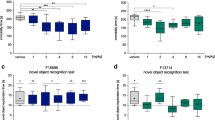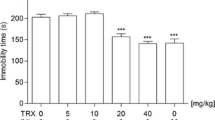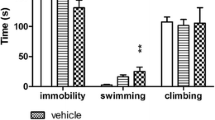Abstract
Low levels of central serotonin (5-HT) have been related to the state of depression, and 5-HT is the major target of the newer antidepressant drugs such as selective serotonin reuptake inhibitors (SSRIs). Neurons and platelets display structural and functional similarities, so that the latter have been proposed as a peripheral model of central functions. In particular, in blood more than 99% of 5-HT is contained in platelets, so that one could consider changes in 5-HT levels in platelets as a mirror of changes in central 5-HT. Here, this hypothesis has been studied via the analysis of the influence of: (1) the forced swimming test (FST, which has been proved to be of utility to predict the clinical efficacy of antidepressants in rodents) and (2) treatment with the SSRI fluoxetine upon 5-HT levels monitored in brain regions and in peripheral platelets by means of electrochemical in vivo and ex vivo measurements. The results obtained confirm that the FST increases immobility; furthermore they show a parallel and significant decrease in cerebral (brain homogenate) and peripheral (in platelet-rich plasma, PRP) voltammetric 5-HT levels following the FST in naive rats. In addition, subchronic treatment with fluoxetine was followed by a significant increase in 5-HT levels in PRP, while the same SSRI treatment performed within the FST resulted in a decrease in the 5-HT levels in PRP. However, this decrease was inferior to that observed without SSRI treatment. These data suggest that there is an inverse relationship between immobility and the levels of 5-HT in PRP and that these peripheral 5-HT levels are sensitive to: (1) the FST, (2) the treatment with fluoxetine and (3) the combination of both treatments, i.e. SSRI + FST. It has been reported that SSRI treatment at first inhibits the 5-HT transporter in brain, resulting in increased extracellular 5-HT, while following sustained SSRI treatments decreased intracellular levels of central 5-HT were observed. Accordingly, the present data show that the initial block of 5-HT reuptake is revealed by the selective increase in 5-HT levels (extracellular content) measured in PRP (not in insulated platelets, IPs) the 1st day of fluoxetine treatment. The initial action of this SSRI upon the 5-HT transporter in brain has also been confirmed by in vivo voltammetric data showing selective increase in the serotonergic signal following local injection of fluoxetine into the brain region studied. Successively, the major effect monitored is a decrease in 5- HT levels, which is more evident in IPs than in PRP. However, it is known that following 2 weeks treatment with an SSRI, 5-HT autoreceptors are desensitized and the serotonin synthesis is restored, together with the intracellular 5-HT levels. The present data showing that the levels of 5-HT in IPs tend to return to control values 12 days after the beginning of chronic fluoxetine treatment suggest that 5-HT levels in IPs (intracellular environment) mirror the influence of SSRI treatment upon the central 5-HT system. On the other hand, at day 12 of the chronic fluoxetine treatment, 5-HT content remains low in PRP. Similarly, low levels of 5-HT have been monitored in brain homogenate of rats chronically treated with fluoxetine. This would support the similarity between PRP preparation and brain homogenate as in both cases cells are disrupted by sample preparation. In conclusion this work supports the literature in proposing platelets as a peripheral model of central functions. In particular, the present data support the idea that peripheral 5-HT platelet levels can reflect the state of the central 5-HT system in conditions of depression. Furthermore, the main outcome of this study is that PRP may mirror central extracellular 5-HT levels, whilst IPs mirror neuronal 5-HT changes.
Similar content being viewed by others
Author information
Authors and Affiliations
Corresponding author
Rights and permissions
About this article
Cite this article
Bianchi, M., Moser, C., Lazzarini, C. et al. Forced swimming test and fluoxetine treatment: in vivo evidence that peripheral 5-HT in rat platelet-rich plasma mirrors cerebral extracellular 5-HT levels, whilst 5-HT in isolated platelets mirrors neuronal 5-HT changes. Exp Brain Res 143, 191–197 (2002). https://doi.org/10.1007/s00221-001-0979-3
Received:
Accepted:
Published:
Issue Date:
DOI: https://doi.org/10.1007/s00221-001-0979-3




